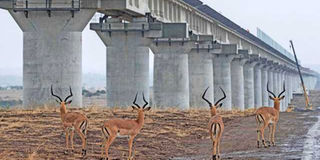Disaster looms as humans, industries choke life out of park

Impalas under elevated standard gauge railway track inside the Nairobi National Park, Kenya, on November 21, 2018. PHOTO | FILE | NMG
What you need to know:
- Nairobi National Park is quietly seeing its life snuffed out as these infrastructural developments human settlements gradually block wildlife dispersal corridors and eat up their habitat, acre after acre.
Toxic pollutants, too, have contaminated water, soil, and air making the park a hazardous place for wildlife.
"It cuts across from the Inland Container Depot (ICD), up to Maasai gate for about seven kilometres,” Mr Josphat Wambua, the Senior Warden at the Nairobi National Park, notes as he trails a line on the map of the park hanging in his office.
His finger traces the line that is the standard gauge railway (SGR) cutting through the park. Then it moves down another line where the Southern Bypass runs by the inner fringes of the park.
“Now there is also the Inland Container Depot (ICD) access road line still going through the park,” he continues.
WILDLIFE CORRIDORS
Kenya Railways is proposing to build a 4.153km access road linking the Nairobi Road A and the Southern Bypass.
Nairobi National Park is quietly seeing its life snuffed out as these infrastructural developments human settlements gradually block wildlife dispersal corridors and eat up their habitat, acre after acre.
Toxic pollutants, too, have contaminated water, soil, and air making the park a hazardous place for wildlife.
The Kenya Wildlife Service has now classified the game sanctuary as an endangered ecosystem. Already existing infrastructural developments have caused the size of the park to shrink by 579 acres, according to Mr Wambua. The park measures 117 square kilometres (28911.3 acres).
But it is the continued hiving off of chunks of park land by the government for national projects that worries him. This and the relentless onslaught by housing estates and factories on the once-wild areas south of the park, spell doom for the future of the park, as the City of Nairobi grows.
Nairobi National Park, which is home to 100 animal species, and 400 migratory and endemic bird types, is a continuation of the Kapiti ecosystem in Athi River, which connected to the Amboseli ecosystem. But housing and fencing off of now privatised land has inhibited the movement of wildlife.
POOR GENES
“We’re moving to a situation where the park is becoming a completely closed ecosystem. That is not an ideal situation when it comes to nature and wildlife. And the entire ecosystem including the vegetation and the rivers are affected.”
Mr Wambua warns that without migration routes and breeding grounds, wildlife numbers would decrease, and the danger of inbreeding might result in poor gene pools, consequently weakening the species.
“The resilience of any ecosystem against these pressures is not infinite. We might think the park is fine right now but definitely with time the park might succumb to the pressures. The effects may not be felt or seen now but might be discovered in the long term,” he argued.
The developments around the park has also fuelled human-wildlife conflict.
Karen Lang’ata District Association communications manager Rose Karobia said encounters with wild animals was becoming frequent in the neighbourhood, forcing residents to be on the lookout always.
“In fact, residents next to the park on the Mukoma-Banda Lane side, have dedicated small boards on road barriers, to update residents of any animal on the loose.”
Mr Wambua says the agency has been encouraging neighbours to allow the movement of the animals in and out of the park.
RAW SEWAGE
Already, he says, they have noticed changes in behaviour of the wild animals probably caused by trauma they suffered during the construction of the SGR.
And even though the animals are slowly trickling back to areas they had previously avoided during the construction phase, it is yet to be seen how they would behave when the line starts full operation.
KWS insists that the contractor had to install noise cancelling devices to minimise vibrations and any unwanted disturbances. The line has also been elevated above the ground.
On pollution in the park, Mr wambua revealed that a recent survey of water in the parks showed that the rivers were contaminated with fecal matter, heavy metals and coliform.
“We had always suspected that overflow from the sewage systems was finding its way here and estates were discharging sewage into the park. This is now a confirmation that it is actually happening,” he said.
“Some like those in Langata and Mlolongo are pumping raw sewage right into the streams which is detrimental to the animals watering from those spots,” he said.
To give an idea of what this may portend for the park, he recounts the 2005 pollution incident at Lake Nakuru that caused low sperm count in resident male flamingos causing a breeding crisis.
Presently, at least 27 species of birds resident in Kenya are classified by the KWS as endangered and threatened birds.





